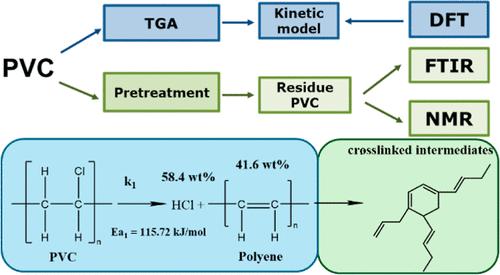当前位置:
X-MOL 学术
›
ACS Sustain. Chem. Eng.
›
论文详情
Our official English website, www.x-mol.net, welcomes your feedback! (Note: you will need to create a separate account there.)
Kinetic Study of Polyvinyl Chloride Pyrolysis with Characterization of Dehydrochlorinated PVC
ACS Sustainable Chemistry & Engineering ( IF 8.4 ) Pub Date : 2024-04-30 , DOI: 10.1021/acssuschemeng.4c00564 Jiayang Wu 1 , Konstantinos G. Papanikolaou 1 , Feng Cheng 1 , Bennett Addison 2 , Amy A. Cuthbertson 2 , Manos Mavrikakis 1 , George W. Huber 1
ACS Sustainable Chemistry & Engineering ( IF 8.4 ) Pub Date : 2024-04-30 , DOI: 10.1021/acssuschemeng.4c00564 Jiayang Wu 1 , Konstantinos G. Papanikolaou 1 , Feng Cheng 1 , Bennett Addison 2 , Amy A. Cuthbertson 2 , Manos Mavrikakis 1 , George W. Huber 1
Affiliation

|
In this paper, we study the kinetics of polyvinyl chloride (PVC) decomposition using a combination of experimental and computational approaches. We develop a simplified kinetic model that contains only two steps: dehydrochlorination of PVC and further decomposition of the PVC residue. The model is consistent with density functional theory (DFT) calculations and experimental data. Dehydrochlorination is an autocatalytic reaction that starts with a tertiary chloride (Cl) and generates hydrogen chloride (HCl) and benzene as the main products. Benzene and HCl formation rates showed similar trends, indicating that HCl likely catalyzes a homolytic carbon–carbon (C–C) bond cleavage, which gives rise to benzene and an aliphatic fragment. We characterized the structure of dehydrochlorinated PVC (PVC residue) by using thermal gravimetric analysis (TGA), Fourier-transform infrared spectroscopy (FTIR), and nuclear magnetic resonance spectroscopy (NMR). FTIR and NMR results indicate that the PVC residue contains 20% quaternary carbon content, indicating a high concentration of cross-linked molecules. We predict that the most probable structure in the cross-linked centers of the PVC residue is cyclohexadiene, which is supported by DFT calculations, FTIR, and NMR.
中文翻译:

聚氯乙烯热解动力学研究及脱氯化氢PVC表征
在本文中,我们结合实验和计算方法研究了聚氯乙烯(PVC)分解动力学。我们开发了一个简化的动力学模型,仅包含两个步骤:PVC 的脱氯化氢和 PVC 残留物的进一步分解。该模型与密度泛函理论(DFT)计算和实验数据一致。脱氯化氢是一种自催化反应,以叔氯化物 (Cl) 为起始原料,生成主要产物氯化氢 (HCl) 和苯。苯和 HCl 的形成速率显示出相似的趋势,表明 HCl 可能催化均裂碳-碳 (C-C) 键断裂,从而产生苯和脂肪族片段。我们利用热重分析 (TGA)、傅里叶变换红外光谱 (FTIR) 和核磁共振光谱 (NMR) 表征了脱氯化氢 PVC(PVC 残留物)的结构。 FTIR和NMR结果表明PVC残渣中季碳含量为20%,表明交联分子浓度较高。我们预测 PVC 残基交联中心最可能的结构是环己二烯,这一点得到了 DFT 计算、FTIR 和 NMR 的支持。
更新日期:2024-04-30
中文翻译:

聚氯乙烯热解动力学研究及脱氯化氢PVC表征
在本文中,我们结合实验和计算方法研究了聚氯乙烯(PVC)分解动力学。我们开发了一个简化的动力学模型,仅包含两个步骤:PVC 的脱氯化氢和 PVC 残留物的进一步分解。该模型与密度泛函理论(DFT)计算和实验数据一致。脱氯化氢是一种自催化反应,以叔氯化物 (Cl) 为起始原料,生成主要产物氯化氢 (HCl) 和苯。苯和 HCl 的形成速率显示出相似的趋势,表明 HCl 可能催化均裂碳-碳 (C-C) 键断裂,从而产生苯和脂肪族片段。我们利用热重分析 (TGA)、傅里叶变换红外光谱 (FTIR) 和核磁共振光谱 (NMR) 表征了脱氯化氢 PVC(PVC 残留物)的结构。 FTIR和NMR结果表明PVC残渣中季碳含量为20%,表明交联分子浓度较高。我们预测 PVC 残基交联中心最可能的结构是环己二烯,这一点得到了 DFT 计算、FTIR 和 NMR 的支持。































 京公网安备 11010802027423号
京公网安备 11010802027423号